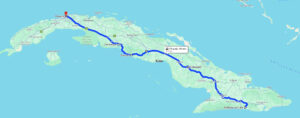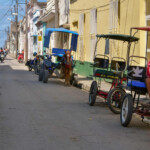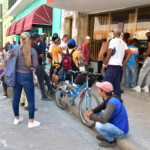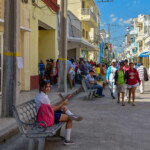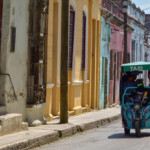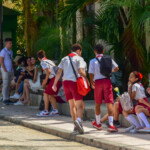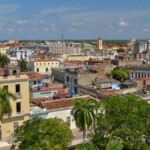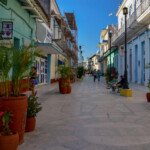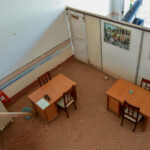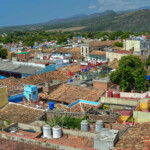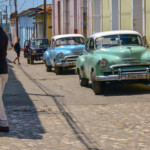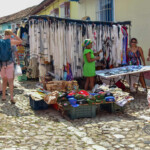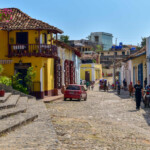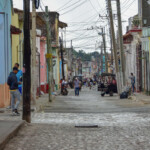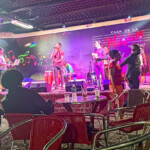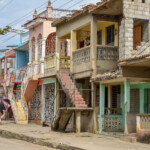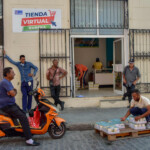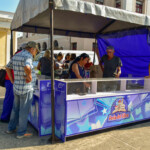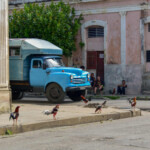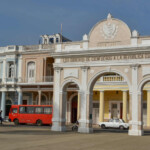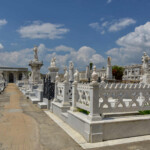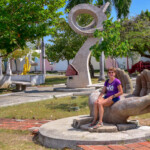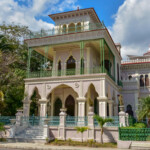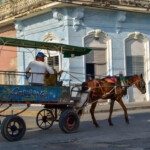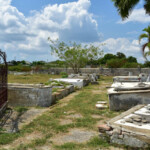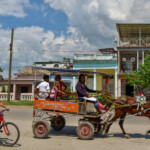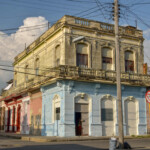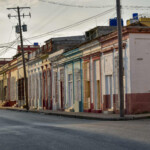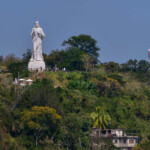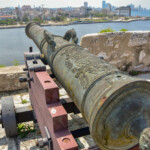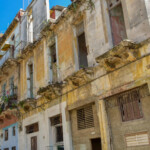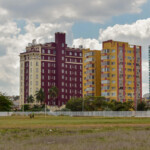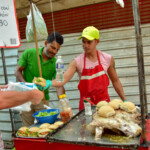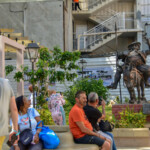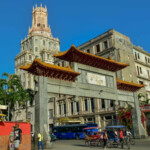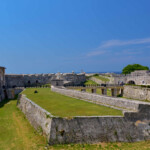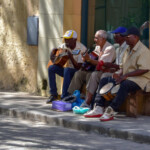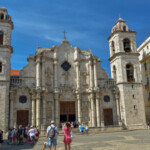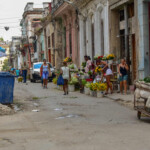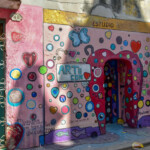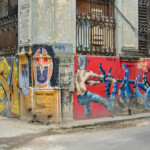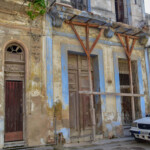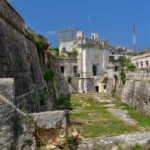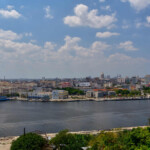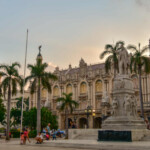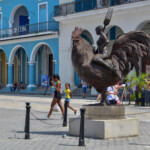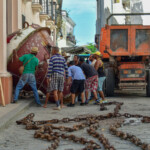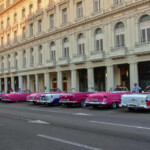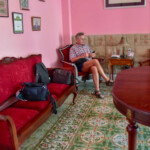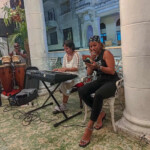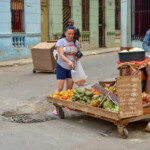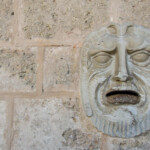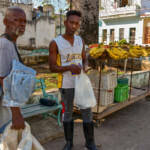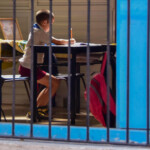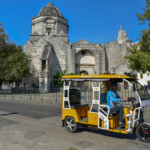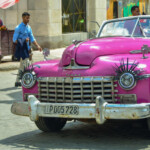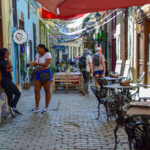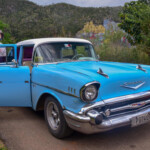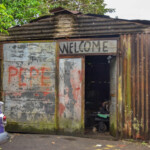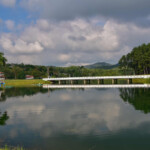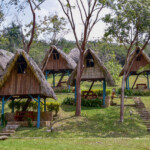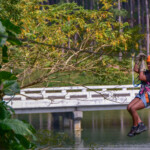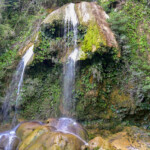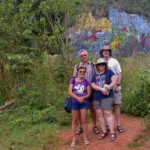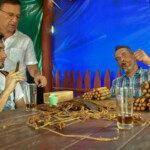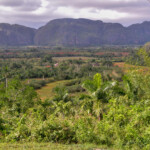Getting around the Cuba
There are several ways to get around Cuba over longer distances:
1. Bus – starting from Viasul – tickets can be purchased via their website – you pay in EUR. It runs between larger cities. You must be at the station at least 1 hour before departure and “check in”, otherwise your ticket will be sold to someone else.
There are also private buses running between cities, you need to sign up on a list with a man on the street (there are many of them), agree on a price, find out the time and place of departure. It is good to contact this person (e.g. by phone). They are usually verbal, although sometimes they get things wrong. You pay this man before boarding the bus (usually in dollars).
The next bus is Omnibus Nacionales – you also have to sign up for the list, you pay in the local currency (CUP), but you don’t know where it leaves from and at what time, but it is much cheaper than the previous bus options.
2. Train – runs every 4 days – there are 4 train routes. It is cheap (Havana-Santiago 132CUP in first class), but to buy a ticket at the station you have to register and enter the list (they check your passport) 3 weeks before the planned departure. Apparently you can buy a ticket at a travel agency, but the price is correspondingly higher.
3. Taxi colectivo – a collective taxi – the driver collects those willing to take the ride, and the costs are shared by all the passengers. Most often, you can find them at train stations or ask a person to stop you on the street – it works.
4. Regular taxi – more expensive than colectivo, but you have the entire taxi to yourself
5. Hiring a driver – you can “buy” a trip with a local driver – if you want to do a full-day trip, it will be cheaper and better than round-trip transport alone, and the local driver will tell you how much the entrance ticket costs in pesos and will point you to a good and cheap restaurant. , will show you interesting places.
6. Renting a car – we haven’t tried this and I don’t think anyone recommends it these days – the roads are poor and the renters are just waiting to charge you for other existing damages.
7. You can travel around the cities by rickshaws (horse, motor, bicycle) – the price must be agreed in advance.
Payments
It’s best to exchange money in town with a trusted person – there is even a special website where black market USD/CUP rates are published.
They usually want payment in USD or EUR for accommodation (in Cuba, USD 1 = EUR 1), and the same for taxis. We paid for food in pubs in CUP (some had menus in USD, but we avoided such restaurants). The stalls have prices in pesos, but they will also accept dollars. It’s important to set a price before buying something/traveling/accommodating etc. – then they stick to it, and if you buy something and don’t set a price, it suddenly turns out that peppers cost as much as gold, and the price of dinner is comparable to dinner at Ritz.
Telephone and internet
The SIM card can be purchased at ETESCA. It costs 1000CUP, so a 12GB internet package costs 950CUP.
You can also buy the card on the street, but there is a high probability, or even certainty, that the card owner will block it after 2 weeks. You can also use scratch cards – in many places there is Internet access, but you need to buy a “scratch card” containing an Internet login and password. In ETESCA, a card for an hour of connection (regardless of the amount of data) costs 25CUP, on the black market you can pay up to $5. Such a card can be used in parts – by logging in and logging out of the website.
Camaguey
Nice and clean town. Capital of the province of Camagüey. In 2008, the historic center of the city was included on the UNESCO World Heritage List. We spend the night in casas patronales. It is called Leydys Villa and is located on Hermanos Aquera Street 6. We highly recommend this place. The apartment is in the very center of the city, very nice lady, nice room with a bathroom and 2 beds. There are towels, soap and toilet paper. There is also a working fridge, TV and air conditioning. Unfortunately, everything runs on electricity.
We climb the cathedral tower and pay 100cups instead of $1 per person. Magic 😀.
To the north, at Plaza de los Trabajadores, stands the massive temple of Iglesia de Nuestra Señora de la Merced, built in 1601 and significantly expanded in the 18th century. The expansion was completed in 1776, creating a magnificent ribbed vault and baroque frescoes. After recently completed renovation, you can admire the beautiful interiors and the Santo Sepulcro, a silver coffin made in the 18th century from coins donated for this purpose.
South of the center lies Parque Ignacio Agramonte, an elegant city square with an equestrian statue of General Agramonte in the center. In the southern frontage there is the Catedra de Nuestra Señora de la Candelaria, dating back to 1530, but thoroughly rebuilt in the 19th century and renovated some time ago. There are two beautiful stained glass windows outside, and inside there is a peculiar statue of the black priest San Benito di Palermo and beautiful wooden vaults.
We go for dinner – for 2 people we pay 1,500 cups with a tip. Dinner was tasty. I took baked chicken and Tomek took ropa vieja.
Santi Spititus
A nice town, more expensive and richer than Camaguey. The accommodation costs $20 per room, but it is large, with a separate living room with a TV. Additionally, we pay $5 per person for breakfast. The town has a nice square, a promenade and a few streets. One day is enough to visit it.
Trinidad
Accommodation costs 3000cup ($10) per room and $5 per person for breakfast (we pay in cup). The room is a little smaller than the previous one, but also large with a bathroom, fridge, air conditioning and fans.
We start the tour from the main square. There is a park with benches, palm trees and amphora-shaped decorations on pedestals. There is a cathedral next door. A bit poor, a few old altars, but no splendor. Next to it is the Romanticism museum, unfortunately closed. They won’t open until Tuesday. The next point is the historical museum (entrance fee 150 CUP per person). The interior is so-so, but the view from the tower is great. Then we go to check the opening hours of ETECSA and stop for lunch. We pay 3000cup for 2 people. On our way back, we meet a private tour of Poles and arrange to go to a concert in the evening. After returning home, it turns out that our lady had already booked us through airbandb for the second night and found us a room next door for the next night. We agree. He refunds us for the second night. Just a quick bath while there is electricity and we go to town. We buy concert tickets for 150 cups per person, buy a mojito at a nearby bar and return to the accommodation. In the meantime, they turn on the electricity, so we turn on the air conditioning.
The concert starts at 2130. We meet the Poles and move to their table.
They play great. Half the room dances salsa, we also try. After 2 hours they start playing Cuban music, a bit sad. We get back home around 2:15 p.m.
In the morning for breakfast we get fruit, omelet, vegetables and cookies. Plus coffee and juice. After breakfast, we make a trip to ETECSA and buy a SIM card for Tomek and top up both cards with 12GB of internet. We also buy 10 scratch cards for 25 cup each.
It turns out that the electricity is turned off at scheduled times. They are different every day, but you can count when. You have to ask the host every time. Today there is electricity from 2 p.m. to 8 p.m., and then 4 hours at night.
We’re moving to the house next door. The room is a bit smaller without a fridge, but there is home internet. The price is the same, i.e. 3000 cups per night.
We eat lunch for 3000cups and then drink coffee with ice cream for 1850cups. This is probably the most expensive coffee so far, but very tasty. We buy a pineapple with peeling service for 400 cups, a beer and go back home. We eat pineapple on the upper terrace of the new place.
Cienfuegos
A taxi colectivo from Trinidad to Cienfuegos costs $15 per person. Two more girls from Hong Kong are coming with us with huge suitcases. In Cienfuegos we pay $15 per room and an additional $5 per person for breakfast.
We leave our backpacks and go to the city. We go to the residential area of Punta Gorda. On the way we enter the marina. This is the marina of the same company as in Santiago – Marlin. In slightly better condition than the one in Santiago, it even has one floating pier. On the way we eat 120cup pizza. We walk to the end of the peninsula, passing small and large residences along the way, most of them have rooms for rent. When we come back, we go for dinner and we pay 2000 cups for 2 people for dinner with beer and delicious food. Unfortunately, in another place we pay almost the same for 2 coffees and a glass of rum.
On our way back, we meet a taxi driver who books us a ride to Havana for $20 per person. On the way we buy pineapples for 80 cups each. A moment later, another man catches up with us and claims that the previous one made a mistake and they cost 160 cups each. We don’t agree to a different price, so we give the pineapples back and the man gives us the money.
There is a book fair on the main square, but it looks very poor. The stands are being set up now, and school supplies are the most popular. We wander around the city, go to the market and buy carrots and peppers for the road. We go back to the room and take a shower. There is no electricity – this time no one knows when they will turn the electricity off and then on.
Another trip to the city, this time we buy water in 1.5 l bottles of 150 cups each. We go to visit the royal cemetery, it consists of two parts, one is nicely kept, the monuments on the graves have been cleaned, the fences have been repainted, and the other part is very neglected, the graves are sunken, the fences are rusty, even though both parts come from a similar period. The figures on the graves in the well-kept part are very beautiful and artistically made. The ones in the second part are damaged and dirty. A caretaker visits the cemetery from time to time, but he doesn’t want anything from us. We take the purchased water back to the room and go look for something to eat. Everywhere is either expensive or there is only pizza and hamburger, and when we find a suitable bar, it turns out that they can’t cook anything because there is no electricity. Finally, we go to the Do Lucio restaurant and grab a set for two with beer and extras for 4,800 cups.
When we come back, we stop for a 25-cup coffee. We have already learned not to order anything in a pub until we see the menu prices in pesos.
As a rule, if there are no prices, we pay a bill that does not correspond to what we ate. Yesterday, Tomek paid 1000cups for a small glass of rum, when such rum in the store costs 1500cups for a 0.75l bottle.
Havana
In the morning, the scheduled taxi arrives to pick us up. We are only going with 2 people, but the taxi driver confirms the price is unchanged. We arrive in Havana a little after 10 a.m. Our room isn’t ready yet, so we drink coffee and juice (it’s included in the price) and go to the train station. Unfortunately, the ticket office is open until 12, and it’s 12:30. We’ll come tomorrow. After returning to the hostel, we get a room next to the patio (the only window overlooks the patio). The room is large, has 2 double beds and one single bed and is almost 4.5m high, a small hall with a fridge and a hanger. There is a bathroom with a bathtub and shower, but no soap. There are towels and toilet paper. All in all, quite good for €11 per day. We’re going to town. First we go to eat something – we pay 1,400 cups for dinner for 2 people, it’s getting better 😀. Havana has bigger houses, but the streets are full of garbage, crowds of tourists on the streets, a little more goods in shops, and prices are generally higher, although outside the tourist center they are comparable to the rest of the country.
We visit the cathedral, look into the castle – it is closed, it will be open from 9:30 from Wednesday to Sunday.
Coming back, we stop for a mojito and coffee. You have to be very careful because coffee can cost from 20 to 600 pesos for the same thing. Same with mojitos. Well, maybe from 150 pesos.
In the morning we go to the hostel for breakfast. There is a buffet, some different croquettes, cheese, vegetables, fruit, bread, rolls and sweets. Additionally, you order an egg in the form of scrambled eggs with additions or fried eggs.
Coffee, chocolate, juices of your choice. The juices are a bit watered down. All in all, the breakfast is solid and tasty. It costs $8 per person.
After breakfast, another visit to the railway station. This time, you put us on the waiting list and we have to report on March 18 and get on the right list. It didn’t even take long, it took the most time to figure out what to do next. The next point is the rum museum. A ticket for a guided tour and tasting of one rum costs 1,200 cups per person. The tour lasts about half an hour, the lady talks about the production process, shows a model of the factory, the old distillery, barrels and talks about the types of rum produced. Then a tasting and, of course, the store, where the prices in dollars are much higher than in stores. The monastery of the Poor Clares, which we would like to see, turned out to be under renovation and we couldn’t enter it. Then we buy vegetables at the market and take them to the fridge in the room. We wander the streets of Havana. There’s a stench everywhere, waste flowing through the gutters, including people offering you a taxi. We don’t really like Havana. It is very different from the places we visited before, where it was poor but at least clean. There are more shops here, more goods in stores, but it’s as if no one cared whether they lived in a pile of death or in a clean house. We buy some rolls for tomorrow’s breakfast and go home.
In the morning we eat rolls bought yesterday and drink coffee from the hostel. Around 11 we move to the “Hotel” casa ecléctica. The rooms are much smaller, the gentleman wants $10 for breakfast, so we give up. We’re going to explore the city. We decide to see the new Havana, so we go west along the seaside boulevard to the Avenue of the Presidents. The district turns out to be full of embassies and former residences, much less damaged than those in the center. We visit the abandoned Castillo del Príncipe, a castle that was also used after the revolution, but is now falling into disrepair. You can enter the area. We stop for dinner and return to the hotel. There is no electricity, we knock on the door, finally the lady opens it, it turns out that the electric button also works without electricity.
We are invited to a neighbor’s birthday party, there are musicians, drinks and some local food. The gentleman reduces the price of breakfast to $5, but without scrambled eggs and fruit. We agree. Around midnight Marek and Marta arrive. We talk for about an hour and go to sleep. We arrange breakfast for 0830.
The breakfast is indeed as we agreed – coffee, juice, rolls and butter. After breakfast, we set out to explore old Havana. We visit the Castillo de la Punta castle – free admission. There are some preserved cannons, empty rooms and a view of Havana and the bay. We’re not doing so well in other places. Most museums are closed on Sunday. Some of them, e.g. Camera Obscura, no longer work. We enter the chocolate museum, which turns out to be a cafe – we order a glass of cold chocolate. Behind the glass you can see a lady making chocolate in various molds. First, he mixes the mass, then puts it into molds and a large refrigerator, and finally removes it from the molds and sells it to guests.
We buy ice cream at the grocery store (we choose 4 different flavours) and return to the hotel. The ice cream turns out to be very tasty. In the evening we play board games on the terrace.
In the morning, we prepare our own breakfast (we eat rolls with meat bought the previous day at a market stall). We’re going to check ourselves on the waiting list, and Marek with Marta go to buy souvenirs at a large bazaar. Checking the list is interesting. Two men come, one of them checks the list and the other writes out the tickets. The numbers you are reading were registered on March 9. The train takes about 100 people from the list. It works like this: you come and sign up for the list by showing your passport, then on the day of the train departure at 11:30 you come and the next numbers are read, people who have a given number come with their ID, the gentleman checks them off on the list and they get a ticket for the next train (in 4 days), which they pay at the ticket office. Taking into account that it was March 18 and the tickets were bought by people from the list from March 9, the waiting time for a ticket was actually about 10 days or more. It turns out that the bus may be a good alternative, but only on Thursday, i.e. the day before departure. Marek and Marta go to visit the ruins of the castle, and we eat pizza and book a trip to Viniales for the next day ($150 for everyone, no additional expenses) in the previous hostel where we stayed. We eat dinner at a Chinese restaurant. Ice cream for dinner.
The next day we take a ferry to the opposite side of the bay. Before entering the waiting room, there is a security check, the lady briefly looks into our bags and backpacks. The ferry costs 2 cups per person, but the smallest denomination is 5 cups. We pay 10cup for 4 people. We reach Casablanca and go to admire a huge statue of Christ, which was brought in pieces from Italy, each part blessed by the Pope.
Then we walk along the military buildings and enter the fortress of San Carlos de la Cabaña. Admission: 200 cups per person. The fortress is huge and very well preserved. At the end, we eat lunch in a pub in the fortress – the prices are very affordable.
After lunch, we go to the next fortress, el Morro (entrance fee 300 cups per person, including guide and entry to the lighthouse). There is a beautiful view of Havana from the top.
We return to the other side by taxi through the tunnel.
Fuerza Castle – entrance fee 120 cups per person. Inside there is an exhibition, cannons and some stories told by the ladies guarding it. From the castle we go for coffee and something to eat to the bar next to the gallery and souvenirs, and then to the bus station. The lady marks on the list that we are here and waiting for the bus. The bus arrives around 3:30 p.m., the lady at the window collects 4,000 cups and we get on the bus. It doesn’t look interesting from the outside, but inside it is quite comfortable, with air conditioning (it later turns out to be a bit excessive). We drive 14 hours to Santiago. Along the way, the bus stops several times for a toilet and twice for a meal. We arrive in Santiago at 6 am and take a taxi back to the marina.
Viniales
We go on a trip from the David and Linda hostel on the next street, we drink coffee and soon the driver comes to pick us up. We’re driving an old Chevy. On the way, we stop at the “workshop” to replace the V-belt. We arrive in Viniales at around 12. It is a beautiful tourist town. Almost every house has accommodation for rent, but there are few tourists. We watch and photograph a mural of prehistory – a colorful, huge painting on a rock. Nice and very suitable for tourists. Even if you get closer, they charge a fee for viewing, but we watch it from a larger perspective. Then we go to visit a tobacco plantation. They show us the seedlings, the tobacco field and the production process. The state purchases 90% of the leaves at the state price. They make cigars from the rest and sell them. Cigars are made by rolling whole tobacco leaves, first removing the central part (core) from the leaf – 80% of the tobacco is collected there. Then it is wrapped tightly in newspaper and waits for about 2 hours, then it is unwrapped from the newspaper and wrapped in the last leaf. Trim the ends and you’re done. Then we get to try the rum they make and we get it as a gift from Marek and Marta for our wedding anniversary next month. Some more coffee (also from their plantation) and we go to the next point, the Cueva del Indio cave. Admission costs 200 cups per person. First, we walk along a beautiful corridor through the cave and then we get on a boat which sails through the next parts of the cave, and the motorboat driver shows us various rock formations, they are beautiful.
We emerge from the other side of the cave. The driver is already waiting for us and we’re going for dinner. For dinner, you choose a main course and there are various side dishes: various rice, vegetables, yucca, etc. It is very tasty, but it is the most expensive dinner we had in Cuba. It works out to $20 per person. Prices are in dollars, of course.
After lunch we return to Havana. We book a trip to La Terasa and Soroya for the next day ($130 for everyone), drink coffee, buy rolls with meat for breakfast the next day and, of course, ice cream.
La Terasa and Saroa
We are traveling with the same driver and the same car as yesterday.
La Terasa is approximately 50 km from Havana. We go to the recreational area – you can see traces of its former glory. The trip costs 200 cups per person.
First we go to the zip line. For a 3-section zip line with equipment and 2 guides, we pay 500 cups per person. A group of about 10 people gathers. We get harnesses with strollers and helmets. staff
fits harnesses and helmets, we also get gloves. We take the bus to the start of the first section. A short training and we’re off. The sections are about 100 m long, they lead along the resort’s lakes, it’s great, great views and great fun. From there we go to the bathing area, there are changing rooms, quite decent with benches. The water in the “pool” is warm and deep enough for swimming. After bathing we go for dinner. We can only choose baked chicken with rice, but it is very tasty. After lunch we go to Saroa. There we see a beautiful waterfall (entrance fee: 360 cups per person), it’s really worth it. Then the driver surprises us and takes us to the viewpoint, from where there is a beautiful view of the entire valley. We go lower and go to see the botanical garden with orchids (entrance fee 400 cups per person). The garden has a lot of different plants, a lot of flowers and a whole corner with orchids. They are beautiful.
After seeing the garden, we return to Havana, and on the way, the driver gives us fresh juice squeezed from sugar cane (guarapa). We get it on ice. It is very tasty. On the way it turns out that my SIM card has stopped working, it looks like the guy who sold it to me blocked it so he could sell it again to someone else. We return to Havana around 6 p.m.



